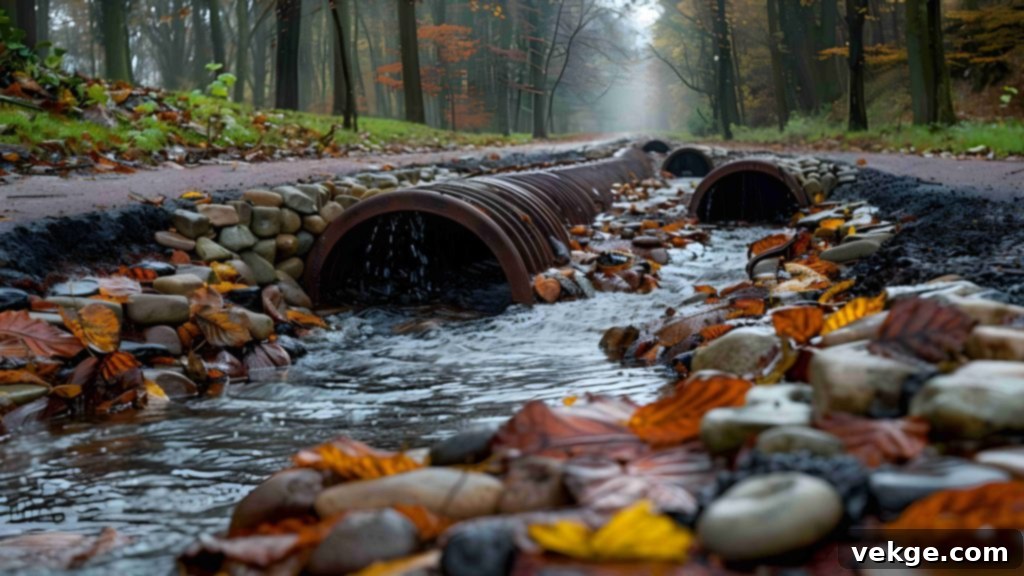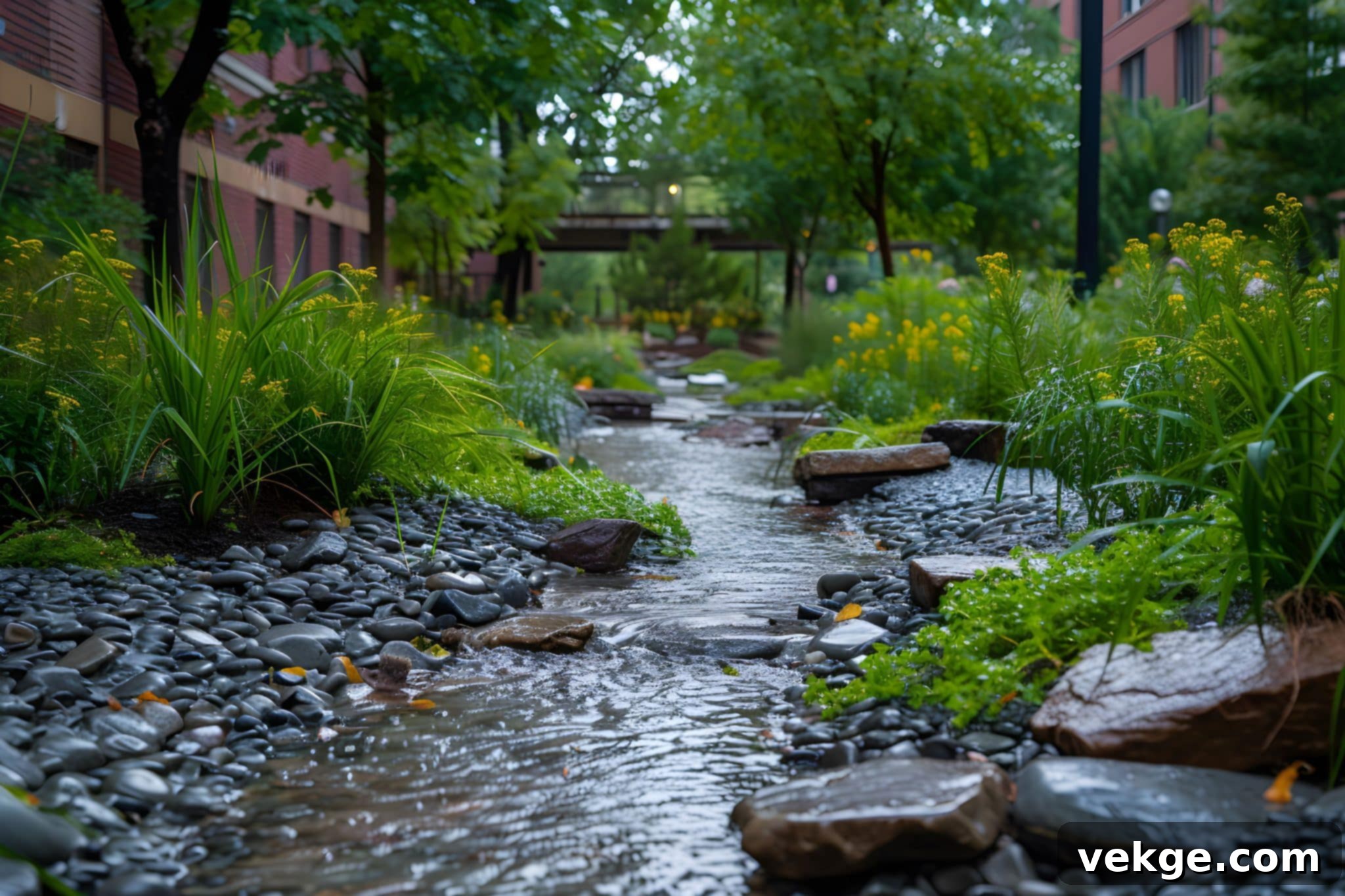Mastering Stormwater Management: An Essential Guide for a Sustainable Yard
Every time rain falls on your property, a natural marvel unfolds. Your yard, much like a giant sponge, possesses an incredible ability to absorb rainwater, naturally filtering it before it embarks on its journey to streams, rivers, and eventually, the vast oceans. This vital process helps maintain the delicate balance of our ecosystems. However, in our increasingly developed world, this natural system can easily become overwhelmed. This is precisely where the challenge of stormwater runoff emerges.
Stormwater runoff refers to rainwater that, instead of soaking into the ground, flows rapidly across impervious surfaces such as rooftops, driveways, and patios. As it rushes over these surfaces, it acts as a conveyor belt, picking up a cocktail of pollutants including chemicals, fertilizers, oil, pet waste, and sediment. This polluted water then discharges into our local waterways, causing significant damage. It degrades water quality, harms aquatic wildlife, erodes stream banks, and can even contribute to localized flooding, creating a cascade of environmental problems that affect us all.
The good news is that you have the power to be a significant part of the solution. By implementing practical and often simple stormwater management practices on your property, you can drastically minimize runoff, prevent valuable topsoil loss, and contribute to a much healthier, more vibrant environment. These actions not only benefit the planet but also protect your home and enhance the beauty and value of your landscape.
Become a Water Detective: Assess Your Landscape
Before diving into various stormwater solutions, the first and most crucial step is to understand how water moves through your specific property. Think of yourself as a “water detective”! Arm yourself with a notebook, a camera, and a keen eye, and venture outside after a good, solid rain. Your observations will provide invaluable insights into your landscape’s unique water flow patterns. Pay close attention to the following aspects:
Observe Pooling and Stagnation
Carefully note any areas where water tends to collect and stand for an extended period. These stagnant puddles are clear indicators of poor drainage, compaction issues, or natural low spots in your yard. Understanding where water collects can help you target specific areas for intervention, such as installing a rain garden or improving soil permeability.
Track Sheet Flow Patterns
Observe how runoff moves across the broader surfaces of your property. Does it flow as a thin, uniform sheet of water, or does it converge into concentrated streams? Uncontrolled sheet flow, especially on sloped areas or compacted soil, is a primary cause of soil erosion, carrying away valuable topsoil and nutrients. Identifying these pathways is key to diverting or slowing down water effectively.
Identify Exit Points
Pinpoint the natural or man-made channels through which water eventually exits your property. This could be a curb cut into the street, a drainage ditch, a storm drain, or even simply flowing onto a neighbor’s yard. Knowing these exit points helps you understand where runoff is ultimately headed and allows you to intercept or redirect it before it leaves your property and potentially contributes to larger community stormwater issues.
These detailed observations will provide you with critical insights into the unique water flow dynamics of your landscape. This information is invaluable when selecting the most appropriate stormwater system or management solution for your yard, ensuring your efforts are both effective and efficient. However, if your assessment leads you to suspect that the problem might stem from issues with your underground water or sewer lines, it’s essential to seek professional help. Reputable and professional plumbers in Olathe, Kansas, or your local area, can accurately diagnose and expertly repair any underlying plumbing issues that could be contributing to drainage problems.
Embrace the Power of Plants: Nature’s Stormwater Solution
Nature provides some of the most beautiful, effective, and sustainable ways to manage stormwater runoff. Integrating specific plant-based solutions into your yard can dramatically reduce runoff, enhance biodiversity, and create a more resilient landscape. These green infrastructure solutions work by mimicking natural processes, allowing water to infiltrate the soil rather than run off.
Cultivate Rain Gardens
Rain gardens are perhaps one of the most aesthetically pleasing and highly effective stormwater solutions. These shallow, intentionally depressed garden beds are specifically designed to capture, hold, and slowly absorb rainwater from impervious surfaces like roofs and driveways. By planting them with native wildflowers, grasses, shrubs, and perennials that are well-adapted to both wet and dry conditions, you create a vibrant ecosystem. Rain gardens not only manage runoff by allowing water to filter into the ground but also reduce pollutants, provide essential habitat for pollinators like bees and butterflies, and add an explosion of color and natural beauty to your property.
Plant Strategic Trees
Trees are natural heroes in stormwater management, acting as living umbrellas and sophisticated water pumps. Their dense canopies intercept rainfall, slowing its descent and allowing some water to evaporate before it even reaches the ground. More importantly, their extensive and deep root systems play a dual role: they stabilize the soil, preventing erosion, and create channels that allow water to infiltrate deeper into the earth. Plant trees strategically around your property, especially near downspouts and paved areas, to maximize their impact. Opt for native tree species that are well-suited to your local climate and soil conditions, as they typically require less water and maintenance while offering greater ecological benefits.
Transition to Native Lawns
Consider moving away from the thirsty, high-maintenance monoculture of traditional turfgrass. Instead, embrace the low-mow charm and ecological benefits of a native lawn. Native grasses and groundcovers are inherently drought-tolerant, requiring significantly less watering, if any, once established. This allows more rainwater to infiltrate the soil rather than pooling or running off. Beyond water conservation, native lawns foster greater biodiversity, providing crucial habitat and food sources for local wildlife, insects, and pollinators. They also often require fewer fertilizers and pesticides, further reducing potential runoff pollution and saving you time and money on maintenance.
Beyond the functional benefit of having a durable concrete stormwater pit for extreme conditions, thoughtfully integrating these beneficial plant elements into your landscape can dramatically reduce stormwater runoff. Simultaneously, you’ll be creating a beautiful, resilient, and biologically vibrant yard that contributes positively to your local ecosystem.
Work with the Water: Capture, Divert, and Utilize
Instead of passively allowing rainwater to rush off your property, take an active approach by capturing, diverting, and utilizing this valuable natural resource. Implementing engineered solutions alongside natural plant systems can significantly enhance your stormwater management efforts, protecting your property and conserving water.
Install French Drains
French drains are an excellent solution for areas prone to excessive moisture or where water needs to be discreetly channeled away. These underground trenches, typically lined with landscape fabric and filled with gravel, contain a perforated pipe at the bottom. This system efficiently collects subsurface water and excess surface runoff, directing it away from building foundations and towards more appropriate infiltration areas like rain gardens, dry wells, or other designated drainage zones. French drains are crucial for preventing water damage to foundations and managing soggy lawn areas.
Opt for Permeable Pavements
Rethink traditional impervious surfaces like solid concrete or asphalt for your driveways, walkways, and patios. Permeable pavements offer a revolutionary alternative. Materials such as gravel pavers, interlocking concrete pavers with wide gaps, porous asphalt, or pervious concrete are designed to allow rainwater to seep directly through their surface and infiltrate into the underlying soil. This not only replenishes groundwater but also significantly reduces runoff volume and associated pollutants. Permeable pavements are a sustainable choice that combines functionality with environmental responsibility, creating aesthetically pleasing and water-wise hardscapes.
Collect with Rain Barrels
Rain barrels are simple yet highly effective tools for capturing rainwater. Install them directly under your downspouts to collect the water that flows off your roof. This free, natural resource provides a chlorine-free water source perfect for watering your plants, gardens, and even washing your car during dry spells. By utilizing rain barrels, you reduce your reliance on municipal water, save money on your water bill, and decrease the amount of stormwater entering the public drainage system. Remember to use collected water within a reasonable timeframe and ensure barrels are properly screened to prevent mosquito breeding.
These diverse water management techniques serve multiple critical purposes. They help conserve a valuable natural resource, actively protect your property from potential water damage and erosion, and significantly contribute to a more sustainable and resilient environment for your community.

Small Changes, Big Impact: Everyday Habits for Stormwater Management
You don’t need to undertake massive landscaping projects to make a difference. Even minor adjustments to your daily habits and property layout can collectively lead to substantial improvements in stormwater management and environmental health. Every small action contributes to a larger positive outcome.
Disconnect Downspouts
Traditionally, downspouts are often designed to channel rainwater directly into storm drains or onto hard surfaces. By strategically disconnecting or redirecting your downspouts, you can divert this flow towards permeable areas such as rain gardens, vegetated lawns, or even a simple splash block leading to a garden bed. This allows for natural infiltration into the soil, reducing the volume of water entering storm sewers and filtering out pollutants before they reach waterways. Ensure the diverted water flows away from your home’s foundation to prevent damage.
Minimize Impervious Surfaces
Impervious surfaces, like concrete, asphalt, and large patios, prevent rainwater from soaking into the ground, drastically increasing runoff. Where possible, consider replacing some of these paved areas with more permeable alternatives such as gravel, pavers with grass joints, or simply leaving space for natural vegetation. Even reducing the footprint of these surfaces can make a significant difference in how your property manages rainfall, encouraging natural water absorption and reducing urban heat island effects.
Compost Yard Waste
Composting kitchen scraps and yard waste is an eco-friendly practice with direct benefits for stormwater management. By creating your own nutrient-rich compost, you reduce the need for synthetic chemical fertilizers on your lawn and garden. Excess fertilizers are a major contributor to water pollution when they wash away with stormwater runoff, leading to harmful algal blooms and ecosystem imbalance in local waterways. Compost also improves soil structure, enhancing its ability to retain moisture and absorb rainwater more effectively.
By consistently making these small, conscious tweaks to your property and daily routines, you actively enable better water management within your neighborhood and significantly cut down on pollution. Over time, these cumulative efforts contribute to healthier local ecosystems, thriving plant and animal life, and ultimately foster a more sustainable and resilient community for everyone.
Conclusion: Your Role as a Backyard Water Hero
By actively managing stormwater runoff on your property, you’re doing far more than simply maintaining your yard – you’re making a profound and tangible contribution to a healthier environment at large. The ripple effects of your efforts are extensive: less runoff means cleaner rivers, lakes, and oceans; it ensures better, safer water for both wildlife and human communities; and it significantly reduces the strain on our municipal storm drain systems, which often struggle to cope with large volumes of polluted water.
Remember, every single drop of water managed effectively on your property contributes to this larger environmental benefit. So, why not roll up your sleeves, let your imagination inspire you, and confidently step into your vital role as a backyard water hero? After all, a truly thriving yard, one that is both beautiful and resilient, fundamentally begins with smart and sustainable rainwater management. Who knew that being eco-friendly could be so rewarding and, dare we say, so much fun?
